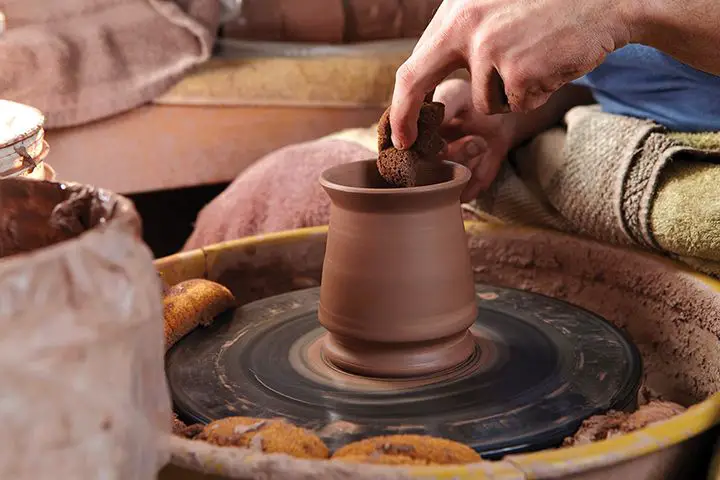What Is The Color Code For Blue Clay?
Blue clay, also known as blue marl, is a type of clay that has a distinct bluish or blue-gray color. The blue coloration comes from the presence of certain minerals and organic compounds within the clay. Specifically, blue clay gets its color from ferrocyanide compounds as well as organic pigments such as vivianite. These compounds are formed through chemical and biological processes as the clay develops over long periods of geological time.
Blue clay deposits are found in many parts of the world, often interbedded with other types of sedimentary clays. The blue color sets it apart from more common clays such as kaolinite that tend to be white, red, or yellow. Some well-known deposits of blue clay occur in China, New Zealand, and the Blue Ridge Mountains of the eastern United States.
The unusual coloration and mineral composition of blue clays make them desirable for a variety of practical and aesthetic uses. Historically, blue clay pigments have been used in traditional decorative arts and pottery. In modern times, blue clay is also valued for its potential industrial and medicinal applications.
Composition
Blue clay, also known as blue marl, is composed primarily of the following minerals and components:
- Kaolinite – This is the main mineral component of blue clay that gives it its distinctive bluish-gray color. Kaolinite is a clay mineral with a chemical composition of Al2Si2O5(OH)4.
- Illite – Another clay mineral that contains potassium. Illite has a flaky structure that contributes to the plasticity of blue clay when wet.
- Montmorillonite – A very soft phyllosilicate group of minerals that forms microscopic crystals. Montmorillonite helps give blue clay its high cation exchange capacity.
- Quartz – Blue clay contains up to 50% quartz particles. The quartz gives blue clay more gritty texture and helps prevent shrinking and cracking when drying.
- Feldspar – A group of rock-forming minerals that contribute aluminum, potassium, sodium and calcium to blue clay.
- Organic matter – Decayed plant matter can provide up to 2% of blue clay’s composition. Organics help give the clay a dark blue-gray color.
The combination of these mineral components is what defines the unique properties and color of blue clay.
Color
Blue clay gets its distinctive color primarily from the presence of complex ferrocyanide compounds. Specifically, the blue hue arises when iron in the clay chemically bonds with ferrocyanides that formed there millions of years ago. This iron-ferrocyanide bonding results in an intense blue pigmentation.
The iron present in blue clays originates from the decomposition of iron-bearing minerals. Meanwhile, the ferrocyanides come from ancient biochemical processes within the clay deposits. When these compounds interact, they create the vivid blue color that makes blue clays so visually striking.
Locations
Blue clay is found in several locations around the world. Some of the most significant deposits are located in:
Southeast Asia – Countries like Thailand, Vietnam, and Cambodia have abundant sources of blue clay in river basins and hillsides. The clay gets its distinctive blue color from high concentrations of organic matter.
Central America – Guatemala and Belize have large deposits of blue clay, often called “Mayan Blue,” near ancient Mayan archeological sites. The clay’s blue pigment came from indigo dye the Mayans added.
Mediterranean Region – Turkey, Greece, Italy and countries along the Mediterranean coast have deposits of blue clay along rivers and streams. Iron oxide in the clay produces the blue-gray coloring.
United States – Blue clay occurs in states like Wyoming, Montana and California. It is often found in volcanic soils rich in minerals that create the blue hue.
New Zealand – Significant reserves of blue clay are located on New Zealand’s north island. The clay develops its blue color from volcanic ash deposits.
Uses
Blue clay has a wide variety of uses due to its distinctive blue color and soft, smooth texture. Some of the main uses of blue clay include:
-
Pottery – The vibrant blue color of blue clay makes it highly desirable for making decorative pottery and ceramics. Many artisans use it to make beautiful vases, bowls, mugs and other pottery items.
-
Cosmetics – Crushed blue clay is used in some cosmetics as a colorant. It provides a bright blue pigment that shows up well against the skin in products like eye shadows, blushes, lipsticks and more.
-
Skin care – Natural blue clay is often used as an ingredient in skin care masks and treatments. It helps cleanse and detoxify the skin while bringing out its natural glow.
-
Paint – In powdered form, blue clay provides an alternative natural blue pigment to synthetically produced blue paints. It is used by some painters as an environmentally friendly colorant.
-
Textiles – Blue clay dye is applied to textiles like silk, wool and cotton to impart a blue tint to the material. It provides a softer, more natural blue color than synthetic dyes.
Mining
Blue clay is typically mined through open pit mining. This involves extracting the clay directly from the ground surface, as opposed to underground shaft mining. The process starts by stripping away the overburden, which includes vegetation, topsoil, and rock that overlays the clay deposit. Heavy machinery is used to remove and stockpile the overburden so that it can be replaced later for reclamation. Once exposed, the blue clay seam is drilled and blasted using explosives to break it up into smaller, more manageable pieces. Powerful mechanical shovels then scoop up the broken clay and load it into large dump trucks. The trucks haul the clay to the processing plant or stockpile where it will be further crushed and refined. As mining advances, the pit widens and deepens to access more of the clay deposit. Once mining is complete, reclamation efforts aim to restore the landscape as close as possible to its original state. This involves backfilling the pit, replacing overburden and topsoil, revegetating, and mitigating any environmental impacts from the mining operation.
Processing
Blue clay requires several steps of processing before it can be used commercially or artistically. When it is first mined, blue clay contains impurities like rocks and organic material. The initial processing removes these contaminants through a combination of crushing, sieving, and washing.
The crushed blue clay is sifted through screens and meshes of varying sizes to filter out large particles. It is then washed thoroughly, sometimes with the aid of detergents, to remove sand, silt, and soluble impurities. This prepares the blue clay into a smooth, consistent texture suitable for further processing or use.
Some applications require the blue clay to be further refined by drying, tempering, and milling. Drying reduces the moisture content, while tempering improves plasticity. Milling grinds the particles into a uniform fine powder optimized for uses like pigments. Proper processing transforms raw blue clay into a versatile material for cosmetics, construction, art, and more.
Color Codes
Blue clay has some specific color codes associated with it in various color models:
RGB
In the RGB (red, green, blue) color model, blue clay is represented approximately by the hex code #686D76. This corresponds to an RGB value of (104, 109, 118).
CMYK
In the CMYK (cyan, magenta, yellow, black) color model used for print, blue clay is represented approximately by a CMYK value of (18, 13, 0, 54). This means it has 18% cyan, 13% magenta, 0% yellow and 54% black.
Pantone
The closest matching Pantone color to blue clay is Pantone 7513 C, which is a medium bluish gray color. The Pantone code allows for accurate color matching across different materials like printing inks, paints, and fabrics.
Artistic Uses
Blue clay has a long history of artistic use due to its distinctive color. When fired, it develops a rich, deep blue hue that has captivated artists for centuries.
In painting, blue clay is used to produce a vibrant blue pigment. The pigment is created by firing raw blue clay at high temperatures, grinding it into a fine powder, then mixing it with a binding medium like linseed oil. This blue clay pigment adds a striking intensity that is difficult to achieve with other blue pigments.
Sculptors also utilize blue clay’s color and plasticity. When moist, the clay can be molded into detailed sculptures which hold their shape when fired. The firing process hardens the sculpture while retaining the blue color. Finished blue clay sculptures have an eye-catching blue tone that creates a unique effect.
Beyond painting and sculpture, blue clay has also been used to dye textiles and create decorative glasswork. The range of artistic applications speaks to the versatile nature of this clay’s vibrant blue color.
Conclusion
Blue clay is a unique type of clay characterized by its distinctive bluish-gray color. It contains high amounts of certain minerals like iron and magnesium that contribute to its coloration. While found in select locations worldwide, blue clay deposits are relatively rare. The clay is prized for its visual appeal and used to make art supplies and pottery. When processed, blue clay’s coloring can range from light blue to dark blue-gray. Each source of blue clay has its own specific color code or identification based on its chemical makeup. Artists may seek out blue clay from a particular locale based on the specific hue they desire. Overall, blue clay is an interesting and visually striking material that has decorative and artistic uses spanning history and culture. Its singular color and composition lead to continued fascination with and demand for this clay.




